
Introduction
Do you want to increase your business’s online reach?
Of course, you do. Since 71% of buyers journeys start with a digital search today; thus, you need to focus on your buyers’ online experience right now.
In fact, SaaS companies can increase their revenue by $1 billion with a better user experience. But here’s a catch—
To provide a better experience to your customers, you have to first understand your customers’ needs and preferences.
In simpler words, if you want to generate a massive CTR (click-through rate) on your content, you have to first know your customers. And for modern businesses, intent data is the best way to gain insight into customers’ behavior patterns.
As intent data is a less explored marketing field, not many marketers still know how to target qualified leads using customer data. Plus, rarely does anyone use intent data to increase CTR.
Therefore, we will uncover different ways intent data and CTR can bring more sales and revenue your way in this guide. So, let’s get started.
Correlation Between Intent Data and CTR
Before getting more clicks on your SaaS product marketing campaigns using intent data, let’s first understand the cohesive relationship between intent data and CTR.
Click-through rate is a ratio that shows how many clicks a specific link has received to the number of times it’s exposed to the people. This ratio is used to measure pay-per-click (PPC) with search engines, hyperlinks in blogs, email campaigns, etc.
A simple CTR calculation formula is:
CTR = (click-throughs / impressions) x 100
For example, if 100 people saw your online ad, but only 5 of them clicked on the ad link and landed on your website, your CTR will be 5%.
From the CTR definition, it’s clear that the more people click or take action on your link, the better CTA you’ll get. In this equation, the main factor is a user’s willingness to click. A user will only click when they find informative and useful content.
And marketers here enter the intent data that will show what your targeted customers find useful. Using intent data, you can analyze your customers intend to purchase your products or services along with many other metrics like:
- What similar products or services are people looking for online?
- Which keywords are online shoppers using to search your products or related products?
- How much is a certain account ready to become your customers? Etc.
So, if you put intent data and CTR together, you can use your potential customers’ intent to buy your products to create personalized marketing campaigns and obtain a massive CTR seamlessly.
These concepts might be different, but they have one end goal — high-quality lead generation. So, this duo can definitely increase reach, revenue, and sales in a massive amount.
What Is a CTR Good for Your Business
The click-through rate is a variable ratio. Depending upon your business industry or marketing style, a CTR keeps on changing. However, an average CTR in Google Ads across all industries is 3.17%.
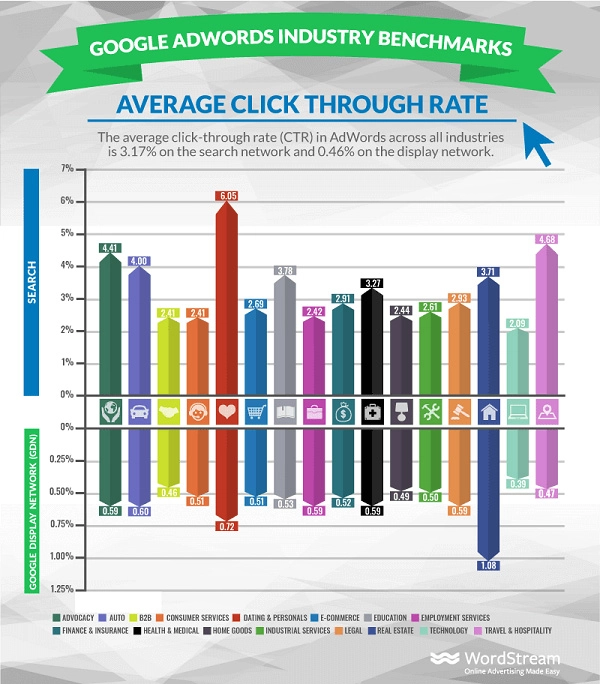
Source: Wordstream
Further, the CTR across different platforms like Facebook, Twitter, or Instagram is different. For example—
- A good CTR on Google ads is 2%.
- On YouTube, it’s 4-5%.
So, if you have an average CTR anywhere near 3%, your marketing team is doing a great job. On the contrary, if your CTR is below 1%, you better start leveraging intent data today.
How to Use Intent Data to Generate a Massive CTR
Intent data is gathered from numerous first, second, and third-party resources around the internet, which can even help you practice account-based marketing for better CTR. But unfortunately, only 18% of marketers are using intent-based marketing strategies currently, and 28% are still on the way to establishing intent-based marketing strategies.
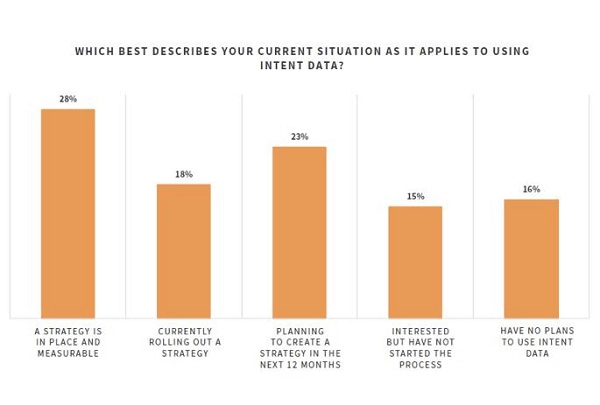
Source: Komarketing
As fewer marketers are yet using intent data, this can give you a competitive edge if you today add intent data into the marketing/sales funnel. Here are a few ways to use intent data for a massive CTR generation:
1. Rephrase Your Content Marketing Strategy
Content marketing is the fundamental step towards gathering buyers’ intent data. Using different content marketing strategies like content syndication, guest blogging, and social media marketing, you can recognize real-time buyers’ intent signals.
Once you have relevant intent data to create account-based ad campaigns, the next step is to optimize it to receive higher CTR. Now, it’s not hard to reframe your content marketing plan according to data. In fact, you have various opportunities to influence CTR with content, such as:
- You can add high-performing keywords in your ad’s headline or copy to align it with your audience’s needs and preferences.
- Write a clear and direct call to action along with a clickable link or button.
- Visuals make your ads look more appealing and engaging. Thus, you should also put the right keywords on your images because Pinterest-like platforms use image recognition technology today.
- Use relevant hashtags to increase your campaign’s organic reach on social platforms like Facebook, Twitter, or Instagram.
For example, look at this LinkedIn ad of LinkedIn Marketing Solutions. The ad has already received 1300+ likes and 40+ comments.
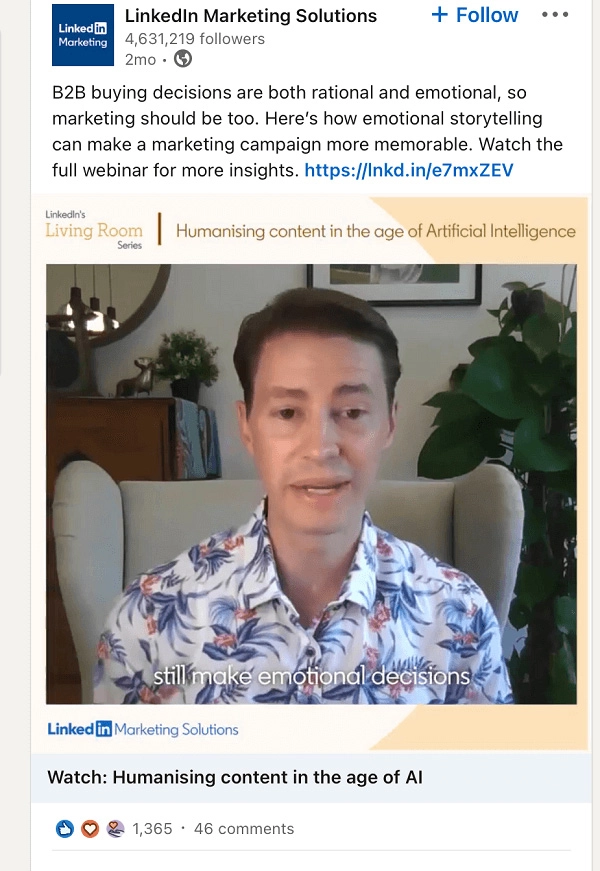
Source: Linkedin
Here you can learn three lessons from this ad — clear CTA button, engaging video content, and utilizing keywords in the description. LinkedIn has created this ad’s content because over 55 million businesses are listed on LinkedIn, and they are always looking for interesting strategies to create powerful marketing campaigns.
So, here if you create your ad campaigns considering user’s preferred keywords and information, you can easily boost your CTR.
2. Recognize Gaps in Product Marketing
Intent data provides a 360-degree view of what type of products your customers are looking for. On top of it, this data throws light on which product is in high demand and which is not performing well.
Intent data can show account-based information that can help you know which product is searched by a particular account. This, in return, boosts CTR as you are promoting relevant products in front of the right account.
Amazon here is the perfect example. On the Amazon website, there are millions of products available in which different groups of buyers are interested. So, Amazon uses the intent data to send emails and social media ads to potential customers.
As a result, the average Amazon conversion rate is around 9.5%. This percentage can vary from around 4% to 50%, depending on the product category.
So, if you sell multiple products like Amazon, knowing intent data can help you target the right prospects and get a massive CTR.
3. Create An Automated Marketing Workflow
Automated marketing workflow helps marketing teams to build a data-driven marketing funnel. That means marketers can understand which products require paid promotions on social media, search engines, and display advertising platforms.
For example, if you find a sudden rise in sport shoe sales on your portal, you can run paid advertising to promote this product category. This way, you can allocate your limited marketing budget to high in-demand products.
You have many different options online to search users intent data, such as:
- You can use LinkedIn Insight tags to analyze the professional traits of your leads.
- Google Analytics and Search Console are two free tools to analyze your site visitors’ data.
- Facebook Ad Manager also helps in collecting customer data.
- There are tools like Hotjar, Inspectlet, and Mouseflow that help in anonymously recording your visitors’ sessions.
4. Tap On Emerging Trends
Do you know 4 in 10 millennials say that their favorite influencer better understands them than their friends? In fact, the US influencer market is growing rapidly nowadays.
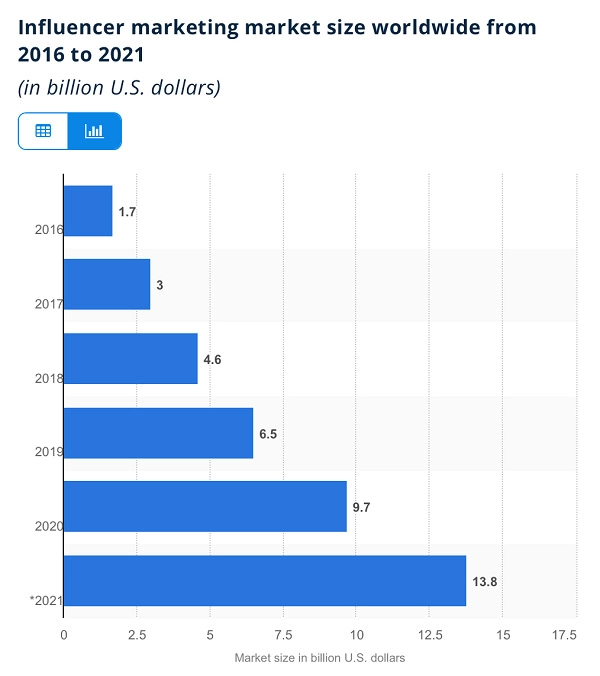
Source: Statista
Using the intent data, you can get more clicks on your celebrity endorsements, social media influencer campaigns, and more. That’s because user data will tell you which celebrity is trending right now among your targeted audience. This knowledge will help you gain a high rate of return on your celebrity campaigns.
Recently, McDonald’s leveraged buyers’ intel data and boosted its third quarter’s sales by 4.6%. To attract millennials and Gen-Z, McDonald’s partnered with rapper Travis Scott and launched a meal with his name, which turned out to be the best-selling menu item across different McDonald’s chains.
5. Helps to Target the Right Platform
You know, people, your CTR isn’t only linked to how you present your ads — it is also connected to where you publish your ad.
Today, there are numerous social media platforms and search engines available globally, which makes it hard to find the right platform to display your ads.
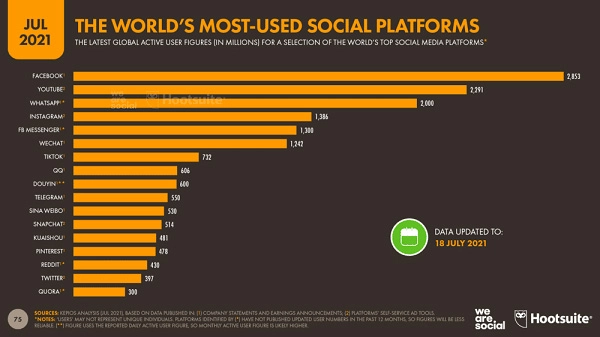
Source: Datareportal
Luckily, when you have intent data in your hand, you can target the right platform to publish your content and get lots of CTR.
For example, if you are a B2B brand, LinkedIn is the place to connect with other professionals and companies. On the contrary, if you are a B2C women’s fashion brand, Instagram and Pinterest are for you.
Intent Data and CTR — a Powerful Duo
Whether you want to improve your sales, revenue, or conversions, the user intent data can help you with everything. It is clear from the post that intent data and CTR are directly related to one another.
If you push more data-driven marketing strategies, your CTR will automatically go up. So, if you are struggling with low CTR, a little investment in intent data can help you a lot.
Marketers, we hope this post has given you something to think about. So, if you find our post useful and interesting, do share it and also check out some other marketing blogs here.
Our blog
Latest blog posts
Tool and strategies modern teams need to help their companies grow.

This comprehensive guide covers everything about service marketing—its unique chara...

Believe it or not, the concept of content sharing existed long before the Internet. I...

Sales analysis is essential to avoid inaccurate forecasts and identify improvement op...




